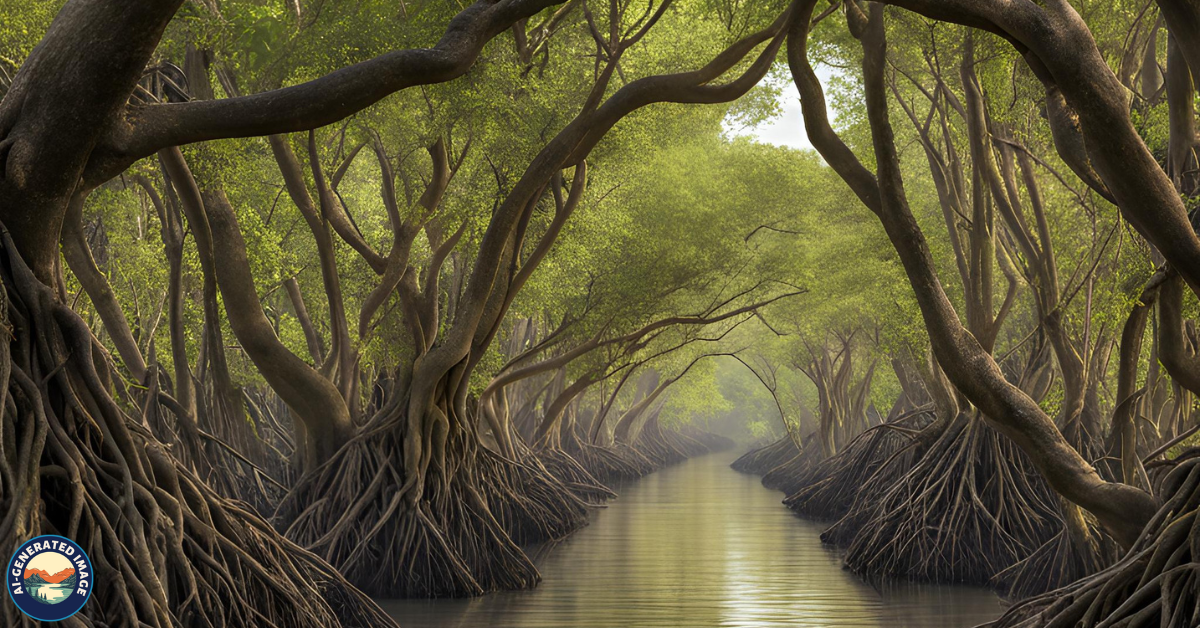Introduction
The Sundarbans is one of the most remarkable natural wonders of the world, renowned for its vast mangrove forests, rich biodiversity, and the elusive Royal Bengal Tiger. Situated in the delta region of the Padma, Meghna, and Brahmaputra river basins, the Sundarbans spans across India and Bangladesh. This UNESCO World Heritage Site is not just a forest; it’s a complex ecosystem that plays a crucial role in the environmental balance of the region.
But what makes the Sundarbans so unique? Why is it considered one of the most significant ecosystems on the planet? In this article, we’ll delve deep into the mysteries and marvels of the Sundarbans, exploring its geography, wildlife, cultural significance, and the urgent need for conservation.
Location and Size
The Sundarbans is located in the coastal region of the Bay of Bengal, primarily within the territories of Bangladesh and India. This mangrove forest is the largest of its kind in the world, covering approximately 10,000 square kilometers, with 60% of the forest in Bangladesh and the remaining 40% in India.
Mangrove Forest
The sheer size of the Sundarbans is awe-inspiring. It stretches over a vast area, creating a dense network of waterways, islands, and mudflats. The forest is interspersed with small rivers, tidal streams, and creeks, making it a unique labyrinth of natural beauty.
The Division Between India and Bangladesh
The Sundarbans is divided between India and Bangladesh, with each country managing its portion of the forest. Despite the political boundary, the ecosystem functions as a single entity, and conservation efforts require cross-border cooperation to ensure the survival of this precious habitat.
Unique Flora and Fauna
The Mangrove Ecosystem
Mangroves are the heart of the Sundarbans. These salt-tolerant trees and shrubs thrive in the intertidal zones, creating a unique ecosystem that supports a wide range of life forms. The dense roots of the mangroves help stabilize the coastline, reduce erosion, and provide a critical habitat for fish, crabs, and other marine organisms.

Royal Bengal Tigers
The Royal Bengal Tiger is the most iconic inhabitant of the Sundarbans. These majestic creatures are perfectly adapted to the challenging environment of the mangrove forest. Unlike tigers in other parts of the world, the Sundarbans tigers are known for their swimming prowess, often seen crossing rivers and hunting in the water. However, their elusive nature and dwindling numbers make them a symbol of both the beauty and the fragility of this ecosystem.

Diverse Bird Species
The Sundarbans is a paradise for birdwatchers. Over 300 species of birds call this forest home, including the rare masked finfoot and the globally endangered lesser adjutant. The rich avian diversity is a testament to the health of the ecosystem, where every species plays a role in maintaining the balance of nature.

Aquatic Life and Reptiles
The waterways of the Sundarbans are teeming with life. From the endangered Ganges river dolphin to the estuarine crocodile, the aquatic biodiversity is both fascinating and crucial for the ecosystem. Reptiles like the king cobra and the Indian python add to the diversity, making the Sundarbans a truly unique habitat.

Climate Regulation
Mangroves as Carbon Sinks
One of the most critical functions of the Sundarbans is its role in climate regulation. The mangrove forests act as significant carbon sinks, absorbing carbon dioxide from the atmosphere and helping mitigate the effects of climate change. This process is vital in the global fight against rising temperatures and environmental degradation.
Protection Against Coastal Erosion and Storm Surges
The Sundarbans serve as a natural barrier against coastal erosion and storm surges, protecting the inland areas from the devastating effects of cyclones and other natural disasters. The dense network of roots and vegetation absorbs the energy of the waves, reducing the impact on human settlements and agricultural lands.
Local Weather Patterns
The presence of the Sundarbans influences the local climate, contributing to more stable weather patterns. The forest helps in the regulation of temperature and humidity, creating a microclimate that supports the diverse life forms in the region.
Human Settlements
Communities
The Sundarbans are home to a diverse array of human communities, many of whom have lived in harmony with the forest for generations. These communities rely on the forest for their livelihoods, engaging in activities like fishing, honey collection, and small-scale agriculture. Their traditional knowledge and sustainable practices are crucial for the conservation of the forest.
Traditional Livelihoods
Fishing is the primary occupation for many inhabitants of the Sundarbans. The rich aquatic resources provide a steady source of income, but the challenges posed by climate change and overfishing threaten this way of life. Honey collection, another traditional activity, involves the careful harvesting of honey from wild bees, a practice that requires skill and respect for the forest’s delicate balance.
Challenges Faced by the Local Population
Life in the Sundarbans comes with its own set of challenges. The rising sea levels, increasing salinity, and frequent natural disasters make survival difficult. Additionally, the human-wildlife conflict, particularly with tigers, adds another layer of complexity to life in this region. The local population’s resilience and adaptability are key to their survival in this harsh environment.
Biodiversity Conservation Efforts
National Parks and Wildlife Sanctuaries
Several national parks and wildlife sanctuaries have been established within the Sundarbans to protect its unique biodiversity. The Sundarbans National Park in India and the Sundarbans Reserve Forest in Bangladesh are key protected areas that play a crucial role in conservation efforts.
International and National Conservation Initiatives
Both India and Bangladesh have implemented various conservation programs to preserve the Sundarbans. International organizations like UNESCO, WWF, and IUCN have also been instrumental in supporting these efforts. These initiatives focus on habitat restoration, wildlife protection, and sustainable development to ensure the long-term survival of the forest.
Role of NGOs
Numerous NGOs are actively involved in the conservation of the Sundarbans. These organizations work closely with local communities, governments, and international bodies to implement conservation strategies, raise awareness, and promote sustainable practices.
Threats to the Sundarbans
Climate Change: Rising Sea Levels and Increased Salinity
Climate change is the most significant threat to the Sundarbans. Rising sea levels are slowly submerging the forest, while increased salinity is affecting the health of the mangroves and the freshwater resources that many species depend on. If these trends continue, the Sundarbans could face irreversible damage.
Deforestation and Illegal Logging
Illegal logging and deforestation pose a severe threat to the Sundarbans. The demand for wood and land for agriculture has led to the destruction of large swathes of the forest, disrupting the delicate balance of the ecosystem and threatening the survival of many species.
Human-Wildlife Conflict
The encroachment of human settlements into the forest has led to an increase in human-wildlife conflict. Tigers, in particular, are often forced to venture into villages in search of food, leading to tragic encounters. This conflict not only endangers human lives but also puts the tiger population at risk.
Pollution and Industrial Activities
Pollution from nearby industrial activities, including the discharge of toxic chemicals into the rivers, is another major threat to the Sundarbans. The contamination of water and soil affects the health of the ecosystem, leading to a decline in biodiversity and threatening the livelihoods of local communities.
Importance of Ecotourism
Sustainable Tourism Practices
Ecotourism has become an essential instrument for conservation in the Sundarbans. By promoting responsible tourism practices, visitors can enjoy the natural beauty of the forest while contributing to its protection. Sustainable tourism helps generate income for local communities, reducing their reliance on destructive activities like logging and poaching.
Popular Tourist Activities
Tourists visiting the Sundarbans can engage in various activities, such as boat safaris, bird watching, and photography. These activities provide a unique opportunity to experience the wilderness of the Sundarbans while raising awareness about the need for conservation.
Ecotourism’s Contribution to Conservation and Local Economy
Ecotourism not only supports conservation efforts but also boosts the local economy. The revenue generated from tourism is used to fund conservation projects, improve infrastructure, and support local communities. This sustainable approach ensures that the Sundarbans can be enjoyed by future generations.
The Sundarbans and the Cultural Heritage
Folklore and Legends Associated with the Sundarbans
The Sundarbans are steeped in folklore and legends. The forest is home to the Bonbibi, a revered deity who is believed to protect the people of this place from the dangers of the forest. These stories are deeply ingrained in the culture of the local communities and play a significant role in their relationship with the forest.
Festivals and Traditions of the Indigenous People
The indigenous people here celebrate various festivals and traditions that reflect their close connection with nature. These cultural practices are an essential part of their identity and contribute to the rich cultural heritage of the region.
Literature and Art
The Sundarbans have inspired countless works of literature and art. From the tales of the Royal Bengal Tiger to the depiction of the mangrove forest’s mystique, it has left an indelible mark on the creative expression of people around the world.
Recent Environmental Changes
Impact of Recent Cyclones and Natural Disasters
This place is highly vulnerable to natural disasters, particularly cyclones. Recent cyclones like Amphan and Yaas have caused widespread damage to the forest, uprooting trees, destroying wildlife habitats, and displacing communities. These events highlight the urgent need for disaster preparedness and resilience-building measures.
Changes in Biodiversity Patterns
Environmental changes, including rising temperatures and altered rainfall patterns, have led to shifts in biodiversity within this place. Some species are struggling to adapt, while others are migrating to new areas. These changes underscore the need for ongoing research and monitoring to understand and mitigate the impacts of climate change.
Adaptation Measures Taken by Local Communities
In response to these challenges, local communities are adopting various adaptation measures. These include building cyclone-resistant homes, diversifying livelihoods, and participating in community-based conservation programs. These efforts are crucial for enhancing resilience and ensuring long-term survival.
The Future of the Sundarbans
Predictions for the Next Decades
The future of this place is uncertain. While conservation efforts have made significant progress, the threats posed by climate change and human activities continue to loom large. Predictions suggest that without urgent action, it could face severe degradation in the coming decades.
Role of Global Policies
Global policies and international cooperation are essential for the protection of this place. Climate agreements, conservation treaties, and sustainable development goals all play a role in shaping the future of this vital ecosystem. The survival depends on the commitment of the global community to preserving our planet’s natural heritage.
Innovative Solutions for Conservation
Innovative solutions are needed to address the challenges facing here. This includes the use of technology for monitoring and protecting the forest, community-based conservation approaches, and the promotion of sustainable livelihoods. By embracing innovation, we can ensure that it continues to thrive for generations to come.
The Economic Importance
Fisheries and Agriculture
The Sundarbans are a vital source of income for the local population. The rich fisheries provide food and employment for thousands of people, while the fertile soil supports small-scale agriculture. These economic activities are closely tied to the health of the ecosystem, making conservation efforts crucial for sustaining livelihoods.
Potential for Sustainable Development
This place offers significant potential for sustainable development. By promoting ecotourism, sustainable fishing, and responsible agriculture, the region can achieve economic growth without compromising the environment. This approach ensures that the benefits of development are shared by both people and nature.
Environmental Protection
Balancing economic growth with environmental protection is the key to the Sundarbans’ future. Development projects must be carefully planned and implemented to minimize their impact on the ecosystem. By prioritizing sustainability, we can ensure that this place remains a thriving and resilient ecosystem.
The Global Significance
Recognition as a UNESCO World Heritage Site
The Sundarbans’ recognition as a UNESCO World Heritage Site underscores its global significance. This designation highlights the need for international cooperation in preserving the forest and its unique biodiversity. It also serves as a reminder of our collective responsibility to protect our planet’s natural wonders.
International Cooperation
International cooperation is crucial for the conservation. Cross-border initiatives, joint research programs, and shared conservation strategies are essential for addressing the challenges facing the forest. By working together, India and Bangladesh can ensure the long-term survival of the Sundarbans.
Global Environmental Dialogue
The Sundarbans play a vital role in the global environmental dialogue. As one of the most significant ecosystems on the planet, it serves as a symbol of the importance of conservation and sustainable development. The lessons learned from this place can inform global efforts to protect our natural heritage.
How to Visit
Best Time to Visit
The ideal time to visit is from November to February when the weather is pleasantly cool and dry. During this period, the chances of spotting wildlife, including the Royal Bengal Tiger, are higher, and the forest is more accessible.
Key Locations and Attractions
Visitors can explore several key locations, including the Sundarbans National Park, Sajnekhali Bird Sanctuary, and the Bhagatpur Crocodile Project. Boat safaris along the river channels offer a unique perspective of the forest, allowing tourists to experience the beauty and serenity of the Sundarbans up close.
Tips for Responsible Tourism
When visiting it is essential to practice responsible tourism. This includes respecting local customs, minimizing your environmental impact, and supporting eco-friendly businesses. By being a responsible traveler, you can help preserve the Sundarbans for future generations.
Conclusion
The Sundarbans is a natural treasure, a place of unparalleled beauty and ecological importance. As the largest mangrove forest in the world, it plays a vital role in the health of our planet. However, this unique ecosystem is under threat, and its future depends on our collective efforts to protect and preserve it.
From its rich biodiversity to its cultural heritage, it offers endless opportunities for exploration and discovery. But more than that, it serves as a reminder of the delicate balance that exists between humans and nature. By embracing sustainable practices and supporting conservation efforts, we can ensure that the Sundarbans continue to thrive for generations to come.
FAQs
What Makes the Sundarbans Unique?
This place is unique due to its vast mangrove forests, rich biodiversity, and the presence of the Royal Bengal Tiger. It’s the largest mangrove forest in the world and plays a crucial role in climate regulation and coastal protection.
How Does Climate Change Affect the Sundarbans?
Climate change poses a significant threat with rising sea levels, increased salinity, and more frequent natural disasters endangering the ecosystem and the species that depend on it.
Can Tourists Visit the Sundarbans Safely?
Yes, tourists can visit safely by following guidelines and engaging in responsible tourism practices. It’s essential to respect local regulations and support eco-friendly tourism initiatives.
What Actions Are Being Taken to Safeguard the Sundarbans?
Numerous conservation efforts are underway to protect national parks, wildlife sanctuaries, and international cooperation. NGOs and local communities also play a vital role in conservation initiatives.
How Can Individuals Contribute to the Conservation of the Sundarbans?
Individuals can contribute to the conservation of this place by supporting sustainable products, engaging in responsible tourism, raising awareness about the forest’s importance, and supporting conservation organizations.

